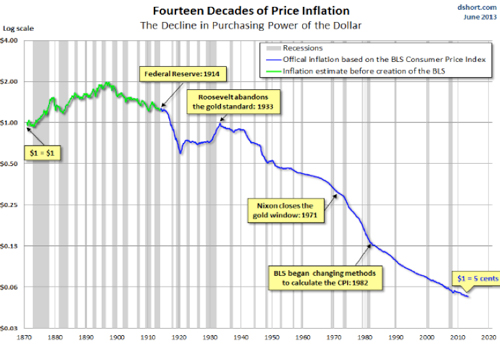While excellent equity market returns coupled with very low volatility have been the name of the game for much of this year, volatility has become the theme in recent weeks as returns across markets have varied quite widely. Despite this recent volatility Equity returns still look strong to date this year as well as for the past year while bonds and commodities continue to struggle.
In recent weeks the Federal Reserve Bank (the FED) led by Ben Bernanke has been busy! At their meeting in mid-June they started to give some guidance in which the seemingly unending stimulus that was termed “QE3” (Quantitative Easing) would start to be tapered off. In September 2012 the FED started buying $40 billion per month of mortgaged backed securities, accelerating that buying to $85 billion per month in December 2012. Their continued purchasing of this debt was pending the economy improving as measured by the Unemployment rate. Recently Bernanke stated:
The Committee currently anticipates that it would be appropriate to moderate the monthly pace of purchases later this year; and if subsequent data remain broadly aligned with our current expectations for the economy, we would continue to reduce the pace of purchases in measured steps through the first half of next year, ending purchases around midyear. In this scenario, when asset purchases ultimately come to an end, the unemployment rate would likely be in the vicinity of 7%, with solid economic growth supporting further job gains – a substantial improvement from the 8.1% unemployment rate that prevailed when the Committee announced this program.
Bernanke also stated that the federal funds rate would be kept in the current 0-0.25% range until the unemployment rate headed below 6.5%. Immediately after this announcement the markets, all markets, sold off. Domestic and International Equities, Bonds and commodities (most notoriously Gold) all sold off as investors sold first and asked questions later. Interest rates on the much quoted 10 year Treasury note shot up significantly in the past month.
The selloff in the fixed income markets seemed justified to us, although maybe not across the board. For the stock markets the reaction seemed rather extreme because over the course of two days, June 19th and 20th, the S&P 500 was off more than 3 times what the Barclays US Aggregate Bond Index was off, ‑3.84% versus -1.21%.
Since then positive news has been negative for markets while negative news has been positive. Signs of an improving economy are met with negative returns because people fear this will accelerate the tapering schedule the FED has laid out. On the other hand stocks have rallied into poor economic data headlines such as “1st quarter GDP revision of economic growth going from 2.4% to 1.8%.” As equity markets find their footing again we would anticipate this to be a short term anomaly and an improving economy should be met with a positive note by markets going forward but only time will tell.
The bottom line is that QE3 was one of the largest forms of stimulus the FED has applied in its history. Although 2008 is not yet a distant memory for most, the economy has been improving consistently now for four years. When put that way it is hard to rationalize these extreme QE measures for too long. We applaud the FED for its transparency as uncertainty is usually a more negative force in the markets than the actual facts.
On behalf of everyone here at The Center,
Angela Palacios, CFP®
Portfolio Manager
On a lighter note, as many of you know Melissa Joy, Partner and Director of Investments here at the Center, generally brings you our investment commentary. However, she is taking a much deserved maternity leave after the birth of Josephine Pearl on June 18th!
Required Disclaimers: The information contained in this report does not purport to be a complete description of the securities, markets, or developments referred to in this material. The information has been obtained from sources considered to be reliable, but we do not guarantee that the foregoing material is accurate or complete. Any information is not a complete summary or statement of all available data necessary for making an investment decision and does not constitute a recommendation. Any opinions are those of Angela Palacios and not necessarily those of RJFS or Raymond James. Investments mentioned may not be suitable for all investors.
There is an inverse relationship between interest rate movements and fixed income prices. Generally, when interest rates rise, fixed income prices fall and when interest rates fall, fixed income prices generally rise. U.S. government bonds are issued and guaranteed as to the timely payment of principal and interest by the federal government. Please note that international investing involves special risks, including currency fluctuations, different financial accounting standards, and possible political and economic volatility. Commodities may be subject to greater volatility than investments in traditional securities. Gold is subject to the special risks associated with investing in precious metals, including but not limited to: price may be subject to wide fluctuation; the market is relatively limited; the sources are concentrated in countries that have the potential for instability; and the market is unregulated.


















